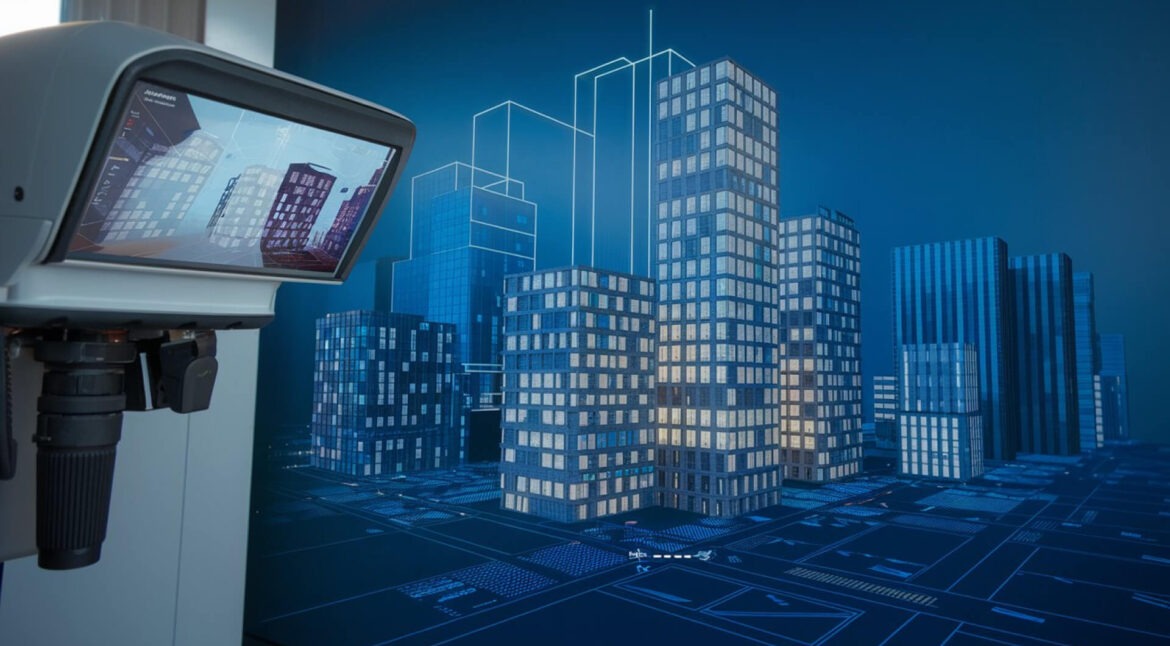Technological advancements in the construction and architecture sectors are growing rapidly, with Scan to BIM resulting as a key achievement. Using 3D scanning technology to capture an actual place and turning the scanned data into a digital model that can be edited and reviewed in BIM software is the process known as “scan to BIM.” This has always been a difficult procedure that needs a lot of manual work. Combining machine learning (ML) and artificial intelligence (AI) is changing the process of scanning to building information modeling (BIM), making it more automated, accurate, and quick.
The Role of Artificial Intelligence (AI) in Scan to BIM
By automating various tedious tasks, AI has the potential to streamline the Scan to BIM process. Identification and classification of objects within a point cloud is one of the most important applications. With the scanned data, AI algorithms can be developed to identify different architectural elements like doors, windows, walls, and structural elements. A point cloud can be turned into a working BIM model much faster due to this automated recognition, which increases productivity and lowers the possibility of human error.
Furthermore, by automatically recognizing and correcting mistakes in the point cloud data, AI-driven tools can improve the accuracy of the BIM models. For example, AI algorithms may determine the missing information based on the surrounding data if a section of the scan is incomplete or contains disruption, resulting in a more accurate and complete model.
Benefits of AI in Scan to BIM
The building and architectural sectors are changing as a result of the incorporation of Artificial Intelligence (AI) in Scan to BIM Services. Using AI in this process offers the following essential advantages:
- Automated Object Recognition: From point cloud data, AI algorithms can automatically identify and classify architectural elements like doors, windows, and walls. By significantly decreasing human error, this automation speeds up the process of creating accurate BIM models.
- Enhanced Accuracy: AI-powered tools can identify and fix issues with the scan data, like noise or missing parts, so that the final BIM model is more accurate and reliable.
- Faster Turnaround Times: Artificial intelligence (AI) reduces the time required to convert a 3D scan into a BIM model by automating manual tasks like data processing and object recognition. This enables more effective workflows and faster project delivery.
- Improved Consistency: By using coordinated modeling and recognition procedures, AI ensures consistency across various projects while lowering the possibility of human error and fluctuation.
- Cost Efficiency: AI can reduce project costs by optimizing the Scan to BIM process and reducing the need for human supervision. This is particularly helpful for large-scale projects where accuracy and timing are crucial.
- Predictive Maintenance: Artificial intelligence (AI) can evaluate data from BIM models to predict maintenance requirements and spot possible problems before they get serious. In addition to lowering long-term operating costs, this proactive approach helps building systems last longer.
- Scalability: AI makes it possible to process massive amounts of scan data effectively, which simplifies the management of complicated and long-term projects. For extensive infrastructure projects or complexes with multiple buildings, scalability is crucial.
- Real-Time Updates: AI can make it easier to process and update BIM models in real time as new scan data is collected. This feature is most helpful in dynamic construction environments where changes happen frequently.
- Data-Driven Insights: AI can analyze BIM models and offer useful data about facility management, construction, and design. Better decision-making and the best project outcomes can result from these insights.
- Innovation and Future Potential: With AI technologies developing constantly, Scan to BIM processes should become even more automated and efficient. The industry may see additional advances in the future because of entirely autonomous systems that can scan and model without the need for human assistance.
Machine Learning’s Impact on Scan to BIM
A type of AI called machine learning goes one step further by consistently enhancing the scan to BIM process via experience. Large-scale databases of previous scans and BIM models are rich sources of information that machine learning algorithms can use to learn and improve their predictions and choices. To ensure a more accurate overlay and minimize the need for manual adjustments, machine learning, for instance, can optimize the alignment of point clouds with current BIM models.
In addition, machine learning can help with predictive maintenance by examining previous data and finding changes that point to possible problems before they develop. In the field of facility management, where accurate BIM models are used to monitor and maintain building systems, this capability is essential. Facility managers can proactively address issues, increasing the lifespan of building systems and lowering operating expenses by integrating machine learning into Scan to BIM technology.
Benefits of Machine Learning in Scan to BIM
Scan to BIM (Building Information Modeling) processes are increasingly utilizing machine learning (ML), an aspect of artificial intelligence. Numerous advantages of machine learning are available to improve the effectiveness, precision, and capabilities of BIM models created from 3D scan data. The following are the main advantages of machine learning for scanning to BIM:
- Continuous Learning and Improvement: Large datasets of earlier scans and BIM models are used by machine learning algorithms to learn from and improve with time. Accurate recognition of architectural elements and enhanced planning for upcoming projects are made possible by this ongoing learning.
- Automated Feature Extraction: From point cloud data, machine learning can detect and extract complex features, such as particular structural elements or complicated design elements. This automation speeds up the process of creating complete BIM models and lessens the need for human intervention.
- Improved Alignment and Registration: By learning from previous alignments, machine learning improves point cloud alignment with current BIM models. As a result, there is less need for manual adjustments and a better fit between the BIM model and the scanned data, leading to more accurate overlays.
- Predictive Analytics: Machine learning can predict future problems or maintenance requirements by analyzing historical BIM data. This feature makes proactive facility management achievable, extending the life of building systems and guiding the prevention of issues before they occur.
- Enhanced Accuracy in Modeling: Machine learning algorithms can more efficiently detect and fix errors in point clouds by learning from large amounts of data. As a result, BIM models become more precise and dependable, which is essential for project success.
- Data Integration and Analysis: Data from multiple sources, including BIM models, IoT devices, and various scans, can be integrated and analyzed by machine learning. Making better decisions is possible because of this holistic approach, which offers an in-depth knowledge of the building and its systems.
- Scalability for Large Projects: With the help of machine learning, large-scale projects with complex structures can be handled by processing massive datasets efficiently. Projects requiring significant facilities or infrastructure must have scalability.
- Time Efficiency: By automating difficult activities and increasing accuracy, machine learning lowers the time needed to process and model scan data. Decisions can be made and projects completed more quickly due to this efficiency.
- Adaptability to Complex Environments: Machine learning algorithms are flexible tools for scanning to BIM because they can adapt to various environments and structural types. Machine learning (ML) can optimize the modeling process according to the particular context, whether it is dealing with industrial facilities, modern architecture, or historical buildings.
- Innovation in Workflow Optimization: By examining task performance patterns and making recommendations for enhancements, machine learning can optimize workflows. In Scan to BIM projects, this leads to more efficient processes that lower expenses and boost productivity.
The Future of Scan to BIM with AI and Machine Learning
The integration of AI and machine learning technologies into Scan to BIM services will advance in ability as these technologies develop further. More advanced automation that generates entire BIM models with a minimum of human involvement is something we should expect. Furthermore, continuous analysis of scan data, made possible by AI and machine learning, will probably allow for quick modifications to BIM models in response to changes that take place on-site.
Long-term developments in AI and machine learning may result in the development of completely autonomous scanning systems that can deal with challenging environments, carry out scans, and update BIM models without the need for human involvement. This level of automation would transform the building and architectural sectors by improving the sustainability, economy, and efficiency of building design, construction, and maintenance.
Conclusion
The future of Scan to BIM technology is being shaped by AI and machine learning. These technologies are revolutionizing building design and management through the automation of essential procedures, enhancement of accuracy, and facilitation of predictive maintenance. The development of these instruments will open up new opportunities for innovation in the building and architectural areas, driving the sector toward a future characterized by increased efficiency and technological advancement.
FAQs
How do AI and Machine Learning impact Scan to BIM technology?
AI and Machine Learning automate data processing, improve accuracy, and streamline workflows, making BIM models more precise and efficient.
What tasks can AI and Machine Learning improve in the point cloud to BIM?
AI and Machine Learning enhance data classification, feature extraction, error detection, and model optimization.
How does AI increase the accuracy of BIM models from scan data?
AI analyzes point cloud data to identify patterns and correct errors, resulting in more accurate BIM models.
Can AI and Machine Learning speed up Scan to BIM processes?
Yes, by automating tasks and reducing manual work, they significantly speed up the process.
What are the future trends for AI in Scan to BIM?
Trends include advanced automation, integration with AR/VR, and enhanced accuracy through improved algorithms.
How does AI help in processing large volumes of scan data?
AI can efficiently process large datasets by automatically identifying and organizing key features, reducing the time needed for manual data handling.
What role does Machine Learning play in improving Scan to BIM software?
Machine learning enhances software by learning from past data, refining algorithms for better feature recognition, and predicting potential issues before they occur.
How can AI and Machine Learning improve the quality of 3D models?
AI and Machine Learning refine model details by automatically correcting errors, filling gaps, and adjusting inaccuracies based on learned patterns from existing data.
Can AI and Machine Learning help in managing and analyzing historical scan data?
Yes, they can analyze historical data to track changes over time, identify trends, and provide insights for future projects.
What are the benefits of integrating AI with other technologies in Scan to BIM?
Integration with technologies like AR/VR can enhance visualization, improve decision-making, and offer interactive experiences for project stakeholders.
How do AI advancements influence the cost of Scan to BIM projects?
AI can potentially reduce costs by automating tasks, minimizing errors, and improving overall efficiency, leading to savings in both time and resources.
Can Machine Learning speed up the Scan to BIM process?
Yes, Machine Learning speeds up the process by automating repetitive tasks, reducing manual input, and accelerating data processing.
How does Machine Learning contribute to error detection and correction in Scan to BIM?
Machine Learning algorithms can identify patterns of common errors, detect anomalies in the data, and suggest or apply corrections, thereby improving the accuracy and reliability of the final BIM model.




